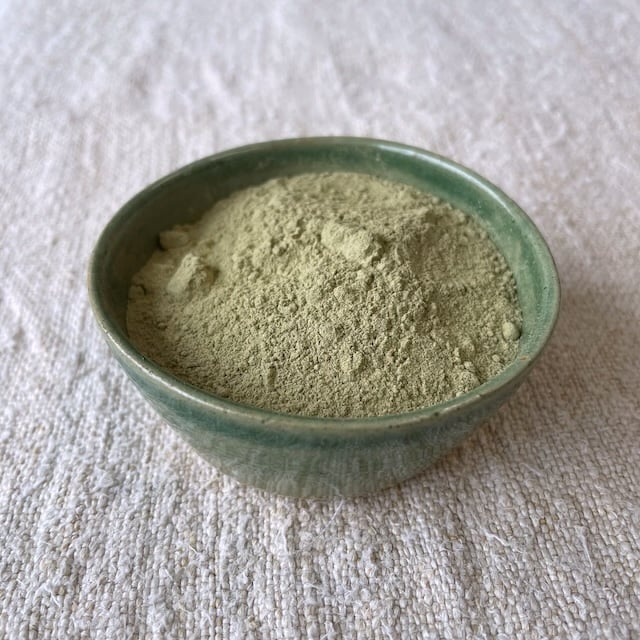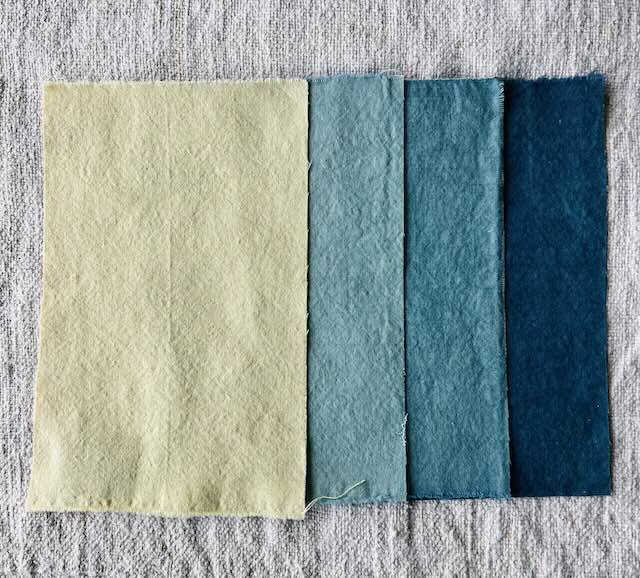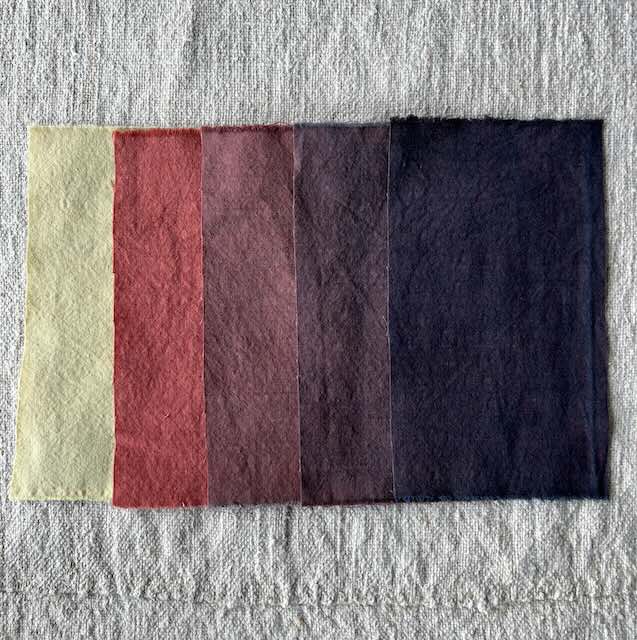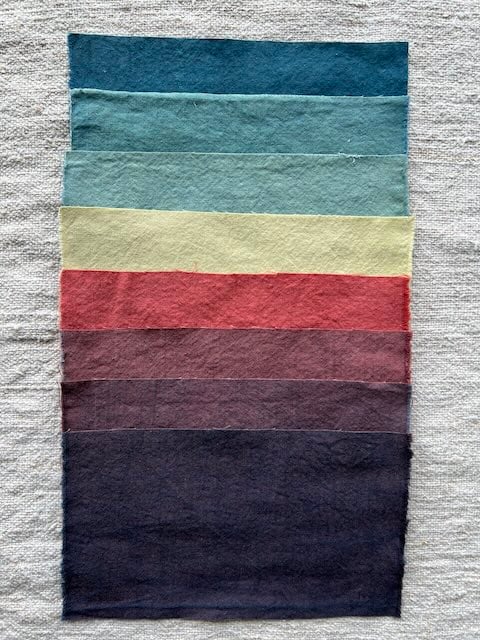
Taking a little time to work more closely with tannins has been incredibly interesting! This week’s tannin exploration focuses on Sumac. Sumac is from the Rhus genus and its scientific name is Rhus coriaria. It’s native to southern Europe and western Asia where it is commonly known as Tanner’s Sumac or Sicilian Sumac. We are fortunate to have number of North American native sumac including Rhus glaubra, sometimes called Smooth Sumac, and Rhus typhina or Staghorn Sumac, known for its dramatic bright red berry clusters. The staghorn berries were used by indigenous people as a tea, and the bark, branches, leaves and roots all contain tannin. The red berries may be used as a tea, a “lemonade” and also ground as a tangy spice. This formulation of sumac that we offer is the ground bark.
I was amazed at how beautiful a base tannin Sumac is. It imparts a light, clear yellow on cotton, making it an ideal foundation for color overdyeing, and indigo combinations. Like our other examples, when combined with other colors you can get exciting mixes and beautiful color blends that harmonize and are perfect for patchwork, creating gradations and stitching.
Skill level: Good for an intermediate or advanced dyer. You should be familiar with cellulose mordanting, using iron as a post-bath, dyeing with natural dye extracts, and indigo dipping and overdyes. If you are an adventurous beginner, try sumac + indigo and as your skills develop, move to the other variations.
The inspiration for using Sumac comes from Sara Buscaglia of Ancient Futures Farm and author of the book Farm & Folk Quilt Alchemy (we have signed copies!) In her book, Sara beautifully articulated some ideas that I’d been mulling over and when I saw the results she achieved, I knew we should dive in and start testing colors. It’s been a lot of fun!
Here are some ideas to get you started. We are dyeing with a variation of the traditional tannin-alum cellulose mordant recipe, but have replaced the tannin source with sumac. Sumac is considered a “light” tannin, meaning it has a subtle yellow color of its own, but doesn’t necessarily have a strong brown tannin component. The results are that color combinations are clear and vivid and look beautiful together.
Sumac and Indigo – the basic sequence

Pictured here are overdyed Sumac samples with Indigo. The light yellow is Sumac on its own. The second swatch is a light indigo overdye, the third swatch is a medium indigo overdye and the far right swatch is a dark indigo overdye.
Start with 4 pieces of cotton, each approximately the size of a fat quarter (18×22 inches)
Scour cotton fabric, using our scour recipe
Then follow our tannin-alum mordant recipe using Sumac in place of Gallo Tannin. Mordant fabric with 10% Sumac, and soak for 1 hour. Then create an alum mordant bath with 15% aluminum sulfate or aluminum potassium sulfate and 1.5% soda ash. Soak the fabric in this bath for 1 hour.
Once the fabric has been mordanted, it will be a light clear yellow. At this point, you can over dye it with indigo. We dipped several different shades and achieved some really nice light teals to warm indigo blues.

Pictured here are from left to right: Sumac with madder extract at 3% and sumac alone.
Sumac with Madder, plus those crazy Madder + Indigo overdyes
We had so much fun with this next set of gradations. After we’d mordanted with sumac and had 5 pieces of yellow fabric, Lisa let her imagination soar and dyed the 4 pieces with madder extract, then dipped 3 of them in various shades of indigo. She achieved very beautiful results.

Start with 5 pieces of cotton, each approximately the size of a fat quarter (18×22 inches). Mordant with Sumac and aluminum sulfate + soda ash as above.
Reserve 1 yellow sumac piece and set aside.
Dye the other 4 pieces with Madder extract at 3%
After dyeing, reserve 1 of the Madder pieces and set aside.
With the remaining 3 pieces, dip one Madder piece in a light indigo vat to achieve a warm purpleish shade that I call a light mulberry.
Dip the next Madder piece in a medium indigo vat to create a deeper raisin shade.
Dip the last Madder piece in a dark indigo vat to create a very dark, mysterious and deep warm purple shade that reminds me of black grapes.
The complete gradation palette for Sumac – spectacular!

To purchase Sumac and try your own set of gradations, the link is here.
Notes:
- All of these colors were mordanted and dyed, with indigo being the last step in the process. This is the reverse of what we normally do in our studio but it makes for some beautiful colors! You can try either sequence to see if one method works better for you.
- Rinse fabrics after mordant, iron post-dip or madder dyeing and before dipping into indigo.
- Rinse after the final indigo dip and air dry away from direct sunlight.
- We always dip our indigo at least twice, and use vats that are light, medium or dark strength.

This is so fantastic! I cannot wait to try this out…. I love all the great mordanting we can do to make our cotton dyeing so fabulous!